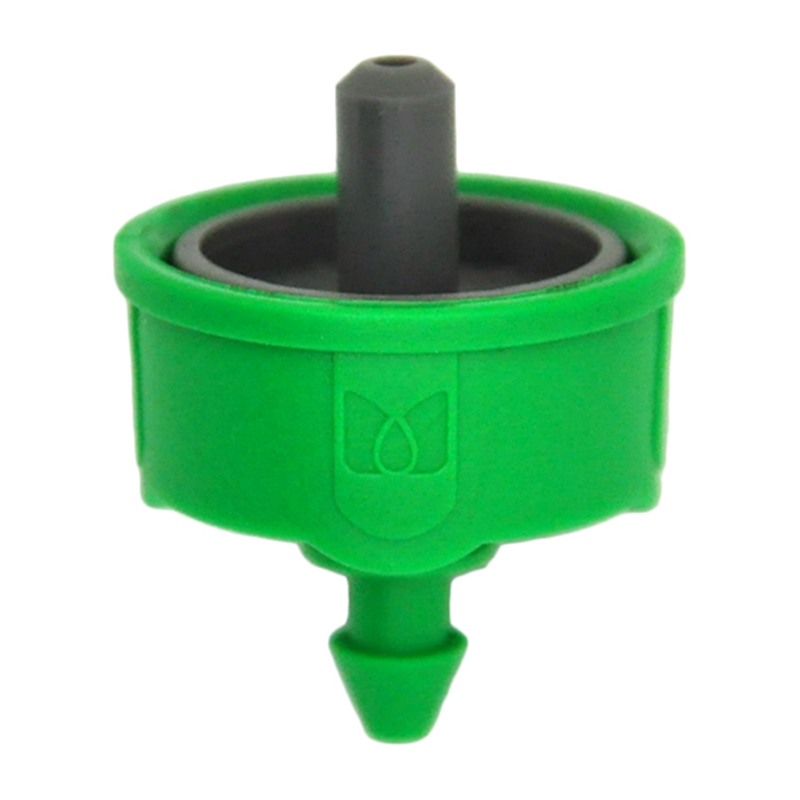No-Drain Pressure-Compensating On-Line Button Drippers are designed to prevent drainage when the irrigation system is turned off through the implementation of specific features.
Here’s how they typically prevent drainage:
- Internal Check Valve:
- No-Drain Drippers are equipped with an internal check valve. This check valve is designed to close tightly when the irrigation system is turned off. The check valve prevents water from continuing to flow through the dripper and into the soil, thus eliminating drainage.
- Positive Shut-Off Mechanism:
- These drippers incorporate a positive shut-off mechanism that ensures a tight seal when the system is not actively irrigating. The mechanism is designed to stop water flow completely, No-Drain Pressure-Compensating (PC) On-Line Button Dripper preventing any residual water from draining out of the dripper.
- Pressure-Compensating Design:
- The pressure-compensating feature in these drippers helps maintain a consistent pressure within the emitter, even when the system is turned off. This constant pressure contributes to the effective closure of the check valve, minimizing the potential for drainage.
- Vacuum Breaker:
- Some No-Drain Drippers include a vacuum breaker feature. This component helps break any vacuum or negative pressure that may build up in the system when it is turned off. By preventing vacuum, the dripper ensures that water stays sealed within the emitter and doesn’t drain out.
- Low-Closing Pressure:
- The check valve in these drippers is designed to close at a low pressure, ensuring that even minimal pressure in the irrigation system, such as residual pressure in the pipes, is sufficient to keep the valve sealed. This low-closing pressure further prevents drainage.
- Smart Dripper Design:
- Some advanced No-Drain Drippers are designed to operate intelligently, responding to changes in pressure and shutting off accordingly. This ensures that the dripper closes tightly during system shutdown, preventing drainage and maintaining water within the drip line.
- Efficient Sealing Materials:
- The materials used in the construction of the check valve and other sealing components are chosen for their durability and efficiency. High-quality sealing materials ensure that the check valve forms a reliable seal, preventing any water from leaking or draining out when the system is off.
- Adaptable to System Pressure:
- No-Drain Drippers are often adaptable to varying system pressures. This adaptability allows them to effectively prevent drainage regardless of the pressure conditions within the irrigation system.
In summary, No-Drain Pressure-Compensating On-Line Button Drippers prevent drainage when the system is turned off through the integration of an internal check valve, positive shut-off mechanisms, pressure-compensating design, vacuum breaker features, low-closing pressure, smart dripper design, and efficient sealing materials. These features work together to ensure that water remains within the drip line, minimizing waste and contributing to efficient water management in drip irrigation systems.
In which agricultural or horticultural applications are No-Drain Pressure-Compensating On-Line Button Drippers commonly used?
No-Drain Pressure-Compensating On-Line Button Drippers find application in various agricultural and horticultural settings where precise and efficient drip irrigation is essential. Some common applications include:
- Field Crops:
- These drippers are used in large-scale cultivation of field crops such as corn, soybeans, cotton, and wheat. The pressure-compensating feature ensures uniform water distribution across the field, optimizing crop yields.
- Vegetable Gardens:
- No-Drain Drippers are well-suited for drip irrigation in vegetable gardens, providing controlled and efficient watering for crops like tomatoes, peppers, lettuce, and carrots. The ability to prevent drainage enhances water use efficiency.
- Orchards and Vineyards:
- Fruit orchards (e.g., apple, citrus) and vineyards benefit from the precise application of water to the root zones. These drippers contribute to water conservation and prevent soil erosion in sloped orchard or vineyard landscapes.
- Nurseries:
- Horticultural nurseries that cultivate plants for later transplantation use No-Drain Drippers to deliver precise amounts of water to potted plants. This is especially important for maintaining consistent moisture levels for seedlings and young plants.
- Greenhouses:
- Greenhouse cultivation of flowers, herbs, and other crops benefits from the accuracy and efficiency of No-Drain Drippers. They contribute to controlled irrigation within greenhouse structures, supporting optimal plant growth.
- Landscaping Projects:
- No-Drain Drippers are employed in landscaping applications for residential, commercial, and public spaces. They are suitable for irrigating flower beds, shrubs, and trees, providing targeted watering without excess runoff.
- Urban Agriculture:
- In urban agriculture settings, such as community gardens or rooftop farms, these drippers are used to efficiently irrigate crops in limited space. The prevention of drainage is particularly valuable in urban environments where water conservation is a priority.
- Coffee Plantations:
- No-Drain Drippers are used in coffee plantations to deliver precise amounts of water to coffee plants. The pressure-compensating feature ensures consistent irrigation across the plantation, contributing to the quality and yield of coffee beans.
- Nuts and Berries:
- Farms cultivating nuts (e.g., almonds, walnuts) and berries (e.g., strawberries, blueberries) benefit from the precision and water efficiency provided by these drippers. They are suitable for both large-scale operations and smaller berry farms.
- Golf Courses:
- Drip irrigation is utilized on golf courses for maintaining turf health. No-Drain Drippers contribute to water conservation and controlled irrigation on fairways, greens, and landscaping features.
- Cotton Farms:
- Cotton cultivation often employs drip irrigation, and No-Drain Drippers are used to deliver water efficiently to cotton plants. The prevention of drainage is crucial in arid regions where water resources are limited.
These applications demonstrate the versatility of No-Drain Pressure-Compensating On-Line Button Drippers across a range of agricultural and horticultural scenarios, emphasizing their effectiveness in water conservation and precision irrigation practices.
